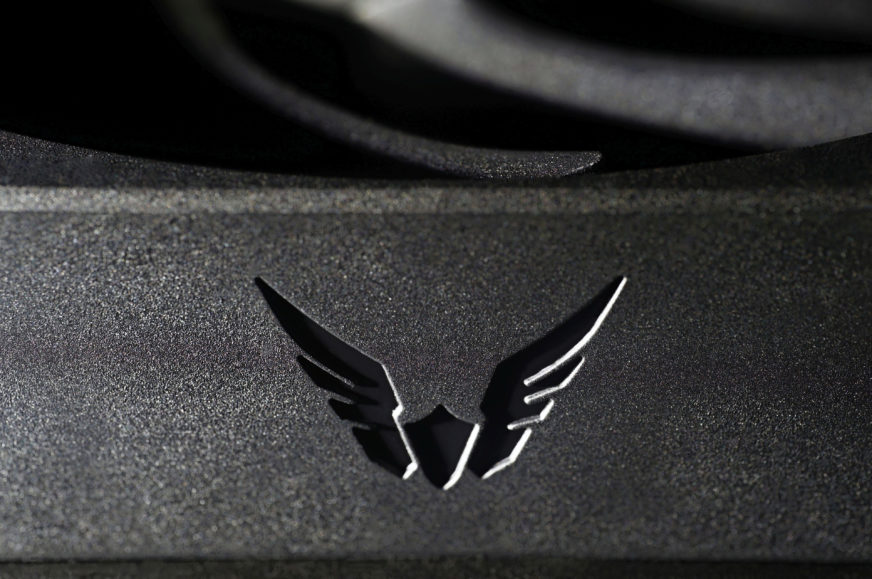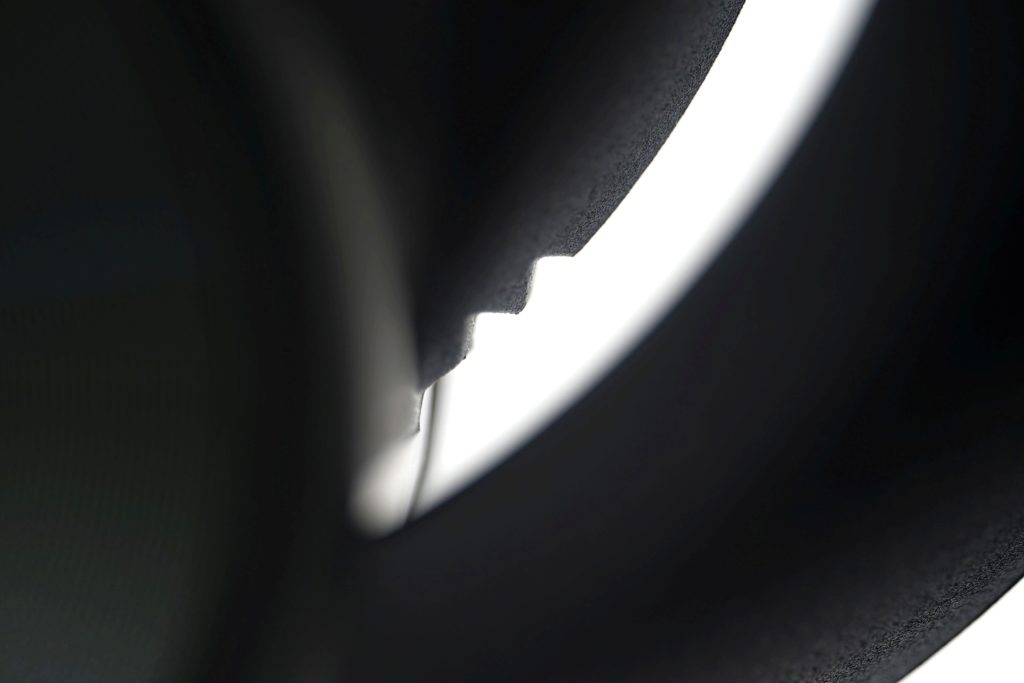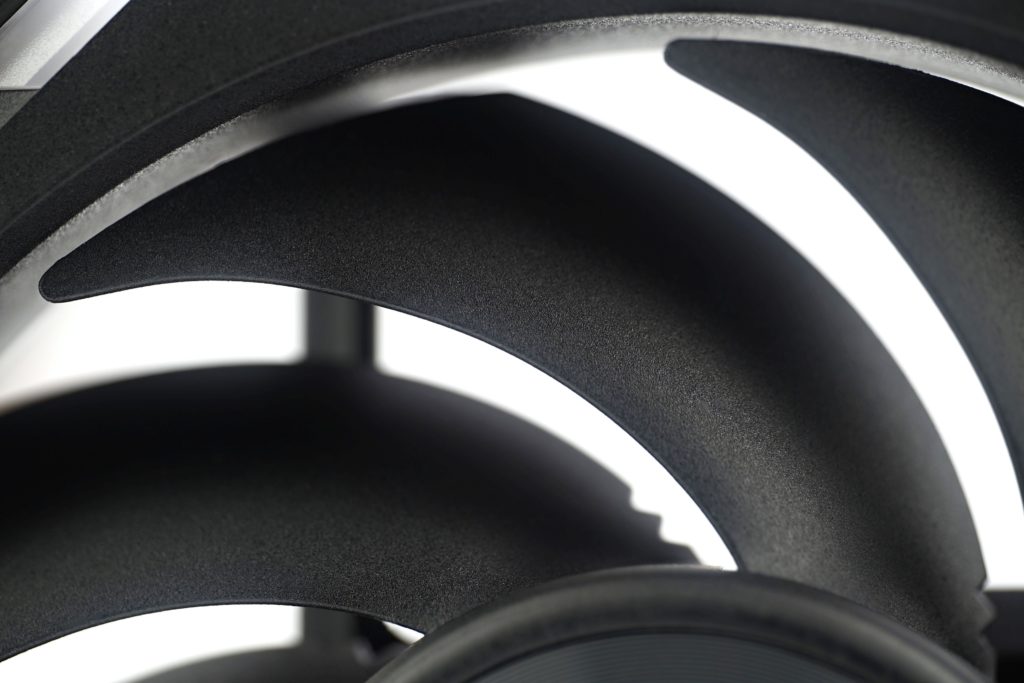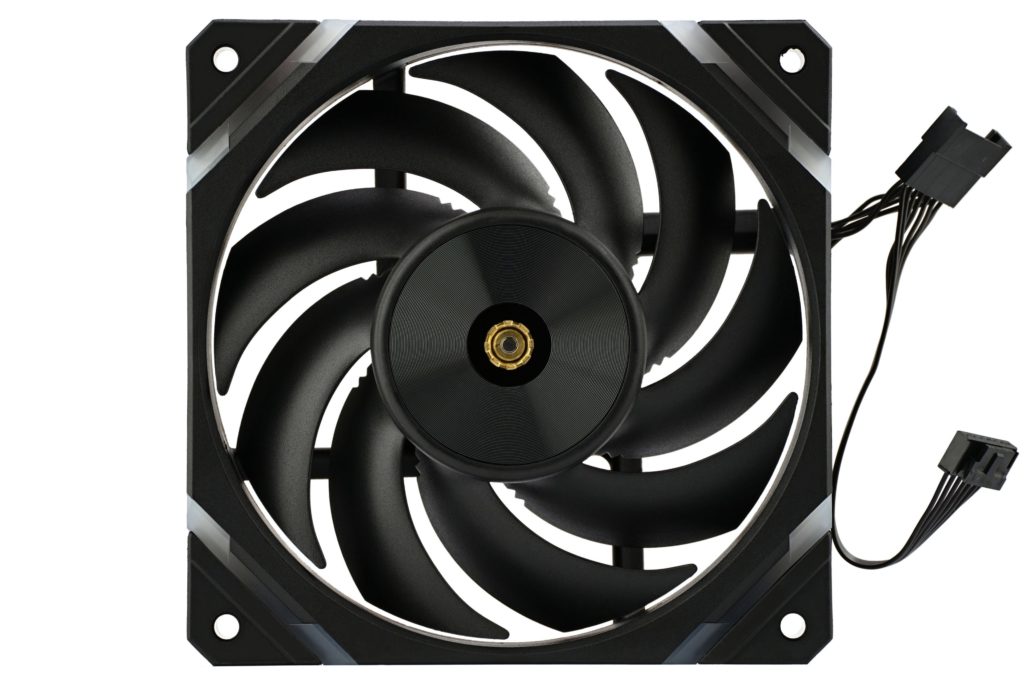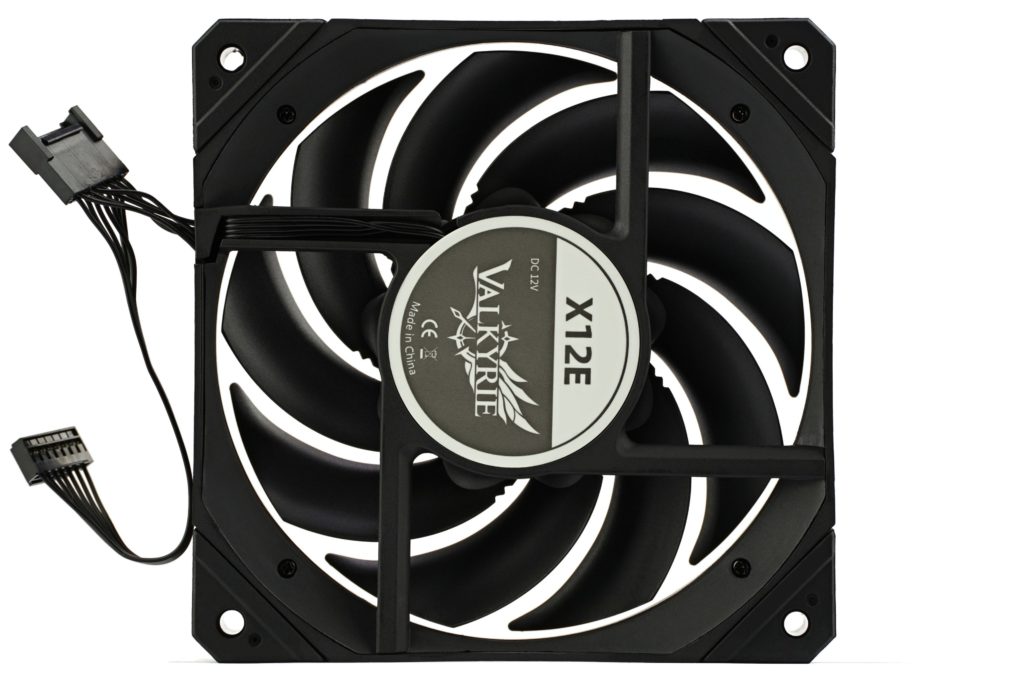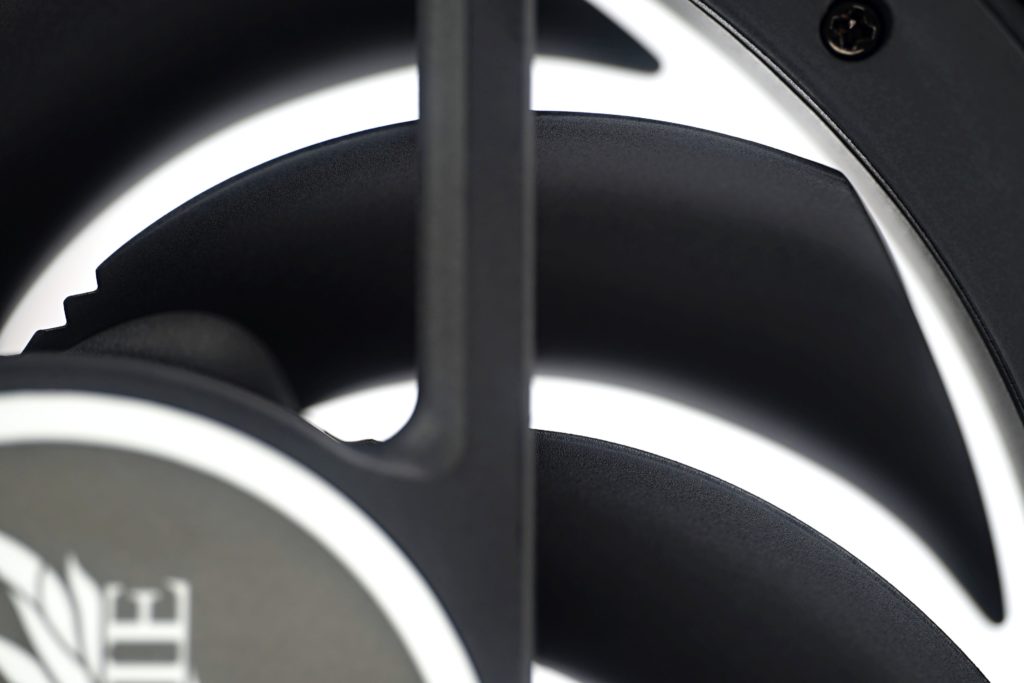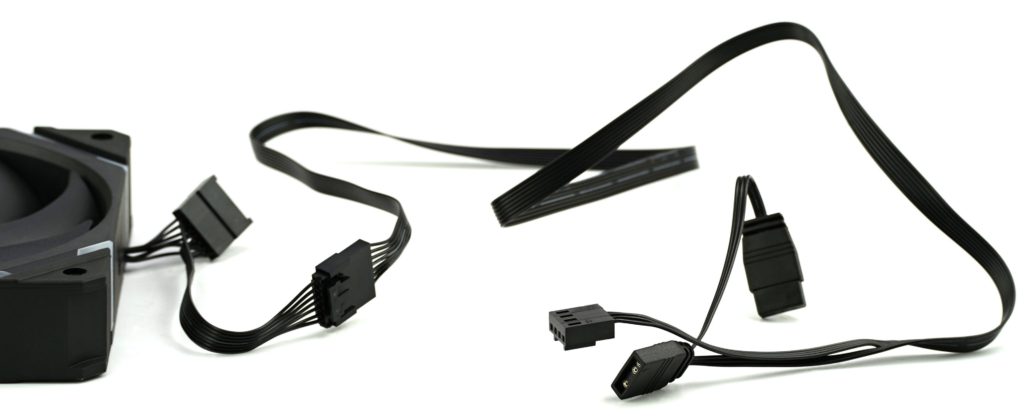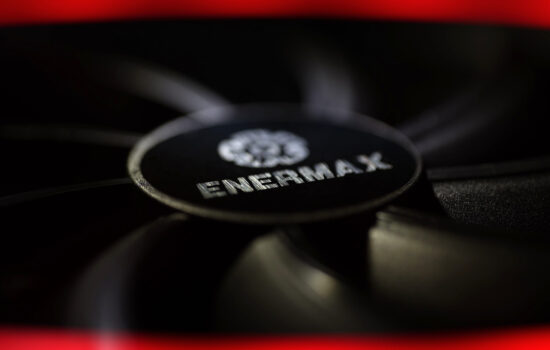Valkyrie X12 in detail
You might be saying that you know the rotor of this fan and that Valkyrie was inspired by the Gentle Typhoon D1225C a little too much. But that’s okay. Mainly the positives were taken from said template and the biggest negative – high vibrations – was avoided. And although some things could still be worked on, in the context of ARGB LED models the X12 fan fares quite well.
The X12 fan belongs to the group of (A)RGB LED models that do not use a rotor to guide the light. This may not look as spectacular and the luminance is always lower due to the smaller permeable area, but it has one big advantage – the rotor can be stiffer than it is with transparent materials.
If there is something atypical and truly original, it is the placement of light guides in the corners of a fan. Usually, ring lighting is used to line the rotor, but Valkyrie has it differently. There are two LEDs (on the PCB) in each corner, on the sides of the lightguide. A long screw goes through the center, which attaches the corners to the rest of the structure. Therefore, by shielding, the brightness drops a bit in places.
The blade geometry is very similar to the Nidec Servo GT D1225C. While this can be claimed for many fans, few fans come closer to it than the X12, for example because of the cutouts on the inside of the trailing edges. You don’t see those on fans much anymore. In the belief that they are unnecessary, fan manufacturers don’t use them. This is natural, given that these cut-outs only serve the role of smoothing out microturbulence – the pressure difference is so small at this point that they are really meaningless in terms of performance.
But there is another dimension to them. From an acoustic point of view, this modification can, in certain circumstances, suppress resonant frequencies from the airflow forming tonal peaks, which likely occurs with the Fractal Design Dynamic X2 GP-12 (PWM). As one of the few representatives of traditional wide blades, on a hexagonal grille at lower speeds it is really quiet even in the 320–350 Hz band. S The FD Aspect 12 (RGB)/PWM without these notches, but with otherwise the same rotor, is significantly noisier similar to the Noctua NF-P12 redux). Naturally this may not work on every fan, it depends on many design factors and sometimes the effect of subtle cut-outs a short distance from the hub may not always be positive either.
Apart from the rounder blade tips, the basic shape of the blades doesn’t differ much from the Gentle Typhoon fan being compared. The inclination is the same and the surface area is almost the same as well. However, the Valkyrie X12 blades are a hair shorter and have more distance from the stator tunnel. This is probably also related to the lower stiffness of the blades, as the PBT doesn’t contain a glass fibre admixture, and although the X12 blades don’t flex too much, they are still thinner compared to the GT D1225C.
Considering that the internal cross-section (hub area) of these fans is also identical, it is extremely unlikely that the Valkyrie X12 fan would achieve significantly higher airflow at the same speed (2150 rpm) compared to the Nidec Servo fan, as stated in the specifications. The X12’s is, for obvious reasons, slightly lower. In one thing Valkyrie has a significant advantage, namely that their fan practically does not vibrate at all.
The blades are, mainly due to their greater thickness, sufficiently stiff to avoid significant vibrations in the operating speed range. Compared to designs with fewer blades, the advantage is that 9-blade fans (i.e. also the X12 case) still have relatively short leading edges and also with a more pronounced curvature. Meanwhile, the fan corners do not really absorb vibrations and are rather a perfect conductor due to their high hardness. But that doesn’t matter at all when there’s nothing to damp. By the way, with 213 grams, this is one of the heaviest fans. Apart from the rotor, the robust frame also contributes a lot to the higher weight.
The fan connection is rather unconventional. Natively, two 6-pin connectors are brought out (one for convenient daisy chaining of other fans), which is an advantage for some splitters. However, if you just want to simply connect the fan to the motherboard or to a splitter that uses 4-pin (motor, PWM) and 3-pin headers (ARGB LED), then you can use the adapter from the 6-pin to do so. This is included in the package and is up to 70 cm in length (82 cm with the cable in, which is enough for cable management even in full tower cases).
And one more thing: To navigate through the result graphs as easily as possible, you can sort the bars according to different criteria (via the button on the bottom left). By (non)presence of lighting, profile thickness, brand, bearings, price or value (with the option to change the sorting to descending or ascending). In the default settings, there is a preset “format” criterion that separates 120mm fans from 140mm fans.
- Contents
- Valkyrie X12 in detail
- Overview of manufacturer specifications
- Basis of the methodology, the wind tunnel
- Mounting and vibration measurement
- Initial warm-up and speed recording
- Base 6 equal noise levels…
- ... and sound color (frequency characteristic)
- Static pressure measurement…
- … and airflow
- Everything changes with obstacles
- How we measure power draw and motor power
- Measuring the intensity (and power draw) of lighting
- Results: Speed
- Results: Airlow w/o obstacles
- Results: Airflow through a nylon filter
- Results: Airflow through a plastic filter
- Results: Airflow through a hexagonal grille
- Results: Airflow through a thinner radiator
- Results: Airflow through a thicker radiator
- Results: Static pressure w/o obstacles
- Results: Static pressure through a nylon filter
- Results: Static pressure through a plastic filter
- Results: Static pressure through a hexagonal grille
- Results: Static pressure through a thinner radiator
- Results: Static pressure through a thicker radiator
- Results: Static pressure, efficiency by orientation
- Reality vs. specifications
- Results: Frequency response of sound w/o obstacles
- Results: Frequency response of sound with a dust filter
- Results: Frequency response of sound with a hexagonal grille
- Results: Frequency response of sound with a radiator
- Results: Vibration, in total (3D vector length)
- Results: Vibration, X-axis
- Results: Vibration, Y-axis
- Results: Vibration, Z-axis
- Results: Power draw (and motor power)
- Results: Cooling performance per watt, airflow
- Results: Cooling performance per watt, static pressure
- Airflow per euro
- Static pressure per euro
- Results: Lighting – LED luminance and power draw
- Results: LED to motor power draw ratio
- Evaluation





